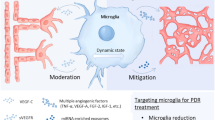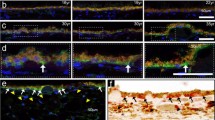Abstract
In ischemic retinopathies, unrelieved hypoxia induces the formation of architecturally abnormal, leaky blood vessels that damage retina and ultimately can cause blindness. Because these newly formed blood vessels are functionally defective, they fail to alleviate underlying hypoxia, resulting in more pathological neovascularization and more damage to retina. With an established model of ischemic retinopathy, we investigated inhibition of glycogen synthase kinase-3β (GSK-3β) as a means for improving the architecture and functionality of pathological blood vessels in retina. In vitro, hypoxia increased GSK-3β activity in retinal endothelial cells, reduced β-catenin, and correspondingly impaired integrity of cell/cell junctions. Conversely, GSK-3β inhibitors restored β-catenin, improved cell/cell junctions, and enhanced the formation of capillary cords in three-dimensional collagen matrix. In vivo, GSK-3β inhibitors, at appropriately moderate doses, strongly reduced abnormal vascular tufts, reduced abnormal vascular leakage, and improved vascular coverage and perfusion during the proliferative phase of ischemia-driven retinal neovascularization. Most importantly, these improvements in neovasculature were accompanied by marked reduction in retinal hypoxia, relative to controls. Thus, GSK-3β inhibitors offer a promising strategy for alleviating retinal hypoxia by correcting key vascular defects typically associated with ischemia-driven neovascularization.







Similar content being viewed by others
References
Chen J, Smith LE (2007) Retinopathy of prematurity. Angiogenesis 10(2):133–140
Gariano RF, Gardner TW (2005) Retinal angiogenesis in development and disease. Nature 438(7070):960–966
Campochiaro PA (2000) Retinal and choroidal neovascularization. J Cell Physiol 184(3):301–310
Frank RN (2004) Diabetic retinopathy. N Engl J Med 350(1):48–58
Boulton M, Foreman D, Williams G, McLeod D (1998) Vegf localisation in diabetic retinopathy. Br J Ophthalmol 82(5):561–568
Miller JW, Adamis AP, Shima DT, D’Amore PA, Moulton RS, O’Reilly MS, Folkman J, Dvorak HF, Brown LF, Berse B et al (1994) Vascular endothelial growth factor/vascular permeability factor is temporally and spatially correlated with ocular angiogenesis in a primate model. Am J Pathol 145(3):574–584
Pierce EA, Avery RL, Foley ED, Aiello LP, Smith LE (1995) Vascular endothelial growth factor/vascular permeability factor expression in a mouse model of retinal neovascularization. Proc Natl Acad Sci U S A 92(3):905–909
Nagy JA, Senger DR (2006) Vegf-a, cytoskeletal dynamics, and the pathological vascular phenotype. Exp Cell Res 312(5):538–548
Forde JE, Dale TC (2007) Glycogen synthase kinase 3: a key regulator of cellular fate. Cell Mol Life Sci 64(15):1930–1944
Cohen P, Goedert M (2004) Gsk3 inhibitors: development and therapeutic potential. Nat Rev Drug Discov 3(6):479–487
Skurk C, Maatz H, Rocnik E, Bialik A, Force T, Walsh K (2005) Glycogen-synthase kinase3beta/beta-catenin axis promotes angiogenesis through activation of vascular endothelial growth factor signaling in endothelial cells. Circ Res 96(3):308–318
Kaga S, Zhan L, Altaf E, Maulik N (2006) Glycogen synthase kinase-3beta/beta-catenin promotes angiogenic and anti-apoptotic signaling through the induction of vegf, bcl-2 and survivin expression in rat ischemic preconditioned myocardium. J Mol Cell Cardiol 40(1):138–147
Kim HS, Skurk C, Thomas SR, Bialik A, Suhara T, Kureishi Y, Birnbaum M, Keaney JF Jr, Walsh K (2002) Regulation of angiogenesis by glycogen synthase kinase-3beta. J Biol Chem 277(44):41888–41896
Yao YY, Yin H, Shen B, Smith RS Jr, Liu Y, Gao L, Chao L, Chao J (2008) Tissue kallikrein promotes neovascularization and improves cardiac function by the akt-glycogen synthase kinase-3beta pathway. Cardiovasc Res 80(3):354–364
Kumar A, Hou X, Lee C, Li Y, Maminishkis A, Tang Z, Zhang F, Langer HF, Arjunan P, Dong L, Wu Z, Zhu LY, Wang L, Min W, Colosi P, Chavakis T, Li X (2010) Platelet-derived growth factor-dd targeting arrests pathological angiogenesis by modulating glycogen synthase kinase-3beta phosphorylation. J Biol Chem 285(20):15500–15510
Smith LE, Wesolowski E, McLellan A, Kostyk SK, D’Amato R, Sullivan R, D’Amore PA (1994) Oxygen-induced retinopathy in the mouse. Invest Ophthalmol Vis Sci 35(1):101–111
D’Amato R, Wesolowski E, Smith LE (1993) Microscopic visualization of the retina by angiography with high-molecular-weight fluorescein-labeled dextrans in the mouse. Microvasc Res 46(2):135–142
Connor KM, SanGiovanni JP, Lofqvist C, Aderman CM, Chen J, Higuchi A, Hong S, Pravda EA, Majchrzak S, Carper D, Hellstrom A, Kang JX, Chew EY, Salem N Jr, Serhan CN, Smith LE (2007) Increased dietary intake of omega-3-polyunsaturated fatty acids reduces pathological retinal angiogenesis. Nat Med 13(7):868–873
Hoang MV, Senger DR (2005) In vivo and in vitro models of mammalian angiogenesis. Methods Mol Biol 294:269–285
Smith LE, Shen W, Perruzzi C, Soker S, Kinose F, Xu X, Robinson G, Driver S, Bischoff J, Zhang B, Schaeffer JM, Senger DR (1999) Regulation of vascular endothelial growth factor-dependent retinal neovascularization by insulin-like growth factor-1 receptor. Nat Med 5(12):1390–1395
Senger DR, Perruzzi CA, Streit M, Koteliansky VE, de Fougerolles AR, Detmar M (2002) The alpha(1)beta(1) and alpha(2)beta(1) integrins provide critical support for vascular endothelial growth factor signaling, endothelial cell migration, and tumor angiogenesis. Am J Pathol 160(1):195–204
Doble BW, Woodgett JR (2003) Gsk-3: tricks of the trade for a multi-tasking kinase. J Cell Sci 116(Pt 7):1175–1186
Bhat R, Xue Y, Berg S, Hellberg S, Ormo M, Nilsson Y, Radesater AC, Jerning E, Markgren PO, Borgegard T, Nylof M, Gimenez-Cassina A, Hernandez F, Lucas JJ, Diaz-Nido J, Avila J (2003) Structural insights and biological effects of glycogen synthase kinase 3-specific inhibitor ar-a014418. J Biol Chem 278(46):45937–45945
Whelan MC, Senger DR (2003) Collagen i initiates endothelial cell morphogenesis by inducing actin polymerization through suppression of cyclic amp and protein kinase a. J Biol Chem 278(1):327–334
Hoang MV, Whelan MC, Senger DR (2004) Rho activity critically and selectively regulates endothelial cell organization during angiogenesis. Proc Natl Acad Sci U S A 101(7):1874–1879
Martinez A, Alonso M, Castro A, Perez C, Moreno FJ (2002) First non-atp competitive glycogen synthase kinase 3 beta (gsk-3beta) inhibitors: thiadiazolidinones (tdzd) as potential drugs for the treatment of alzheimer’s disease. J Med Chem 45(6):1292–1299
Plotkin B, Kaidanovich O, Talior I, Eldar-Finkelman H (2003) Insulin mimetic action of synthetic phosphorylated peptide inhibitors of glycogen synthase kinase-3. J Pharmacol Exp Ther 305(3):974–980
Shima DT, Adamis AP, Ferrara N, Yeo KT, Yeo TK, Allende R, Folkman J, D’Amore PA (1995) Hypoxic induction of endothelial cell growth factors in retinal cells: Identification and characterization of vascular endothelial growth factor (vegf) as the mitogen. Mol Med 1(2):182–193
Pe’er J, Shweiki D, Itin A, Hemo I, Gnessin H, Keshet E (1995) Hypoxia-induced expression of vascular endothelial growth factor by retinal cells is a common factor in neovascularizing ocular diseases. Lab Invest 72(6):638–645
Robinson GS, Pierce EA, Rook SL, Foley E, Webb R, Smith LE (1996) Oligodeoxynucleotides inhibit retinal neovascularization in a murine model of proliferative retinopathy. Proc Natl Acad Sci U S A 93(10):4851–4856
Wangsa-Wirawan ND, Linsenmeier RA (2003) Retinal oxygen: fundamental and clinical aspects. Arch Ophthalmol 121(4):547–557
Loberg RD, Vesely E, Brosius FC 3rd (2002) Enhanced glycogen synthase kinase-3beta activity mediates hypoxia-induced apoptosis of vascular smooth muscle cells and is prevented by glucose transport and metabolism. J Biol Chem 277(44):41667–41673
Medina M, Castro A (2008) Glycogen synthase kinase-3 (gsk-3) inhibitors reach the clinic. Curr Opin Drug Discov Devel 11(4):533–543
Acknowledgments
We thank the V. Kann Rasmussen Foundation for financial support. This work also was supported by NIH grants CA129339 and NS064498 (DRS), NIH grants EY017017 and EY017017-S (LEHS), The Roche Foundation for Anemia Research (LEHS), and a Research to Prevent Blindness Senior Investigator Award (LEHS).
Author information
Authors and Affiliations
Corresponding author
Rights and permissions
About this article
Cite this article
Hoang, M.V., Smith, L.E.H. & Senger, D.R. Moderate GSK-3β inhibition improves neovascular architecture, reduces vascular leakage, and reduces retinal hypoxia in a model of ischemic retinopathy. Angiogenesis 13, 269–277 (2010). https://doi.org/10.1007/s10456-010-9184-y
Received:
Accepted:
Published:
Issue Date:
DOI: https://doi.org/10.1007/s10456-010-9184-y




